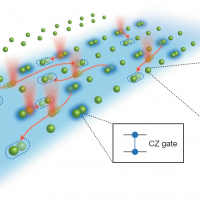News
The Harvard-MIT CUA collaboration led by Lukin, Greiner, and Vuletic reported a new architecture for quantum information processing using the coherent transport of neutral atoms in an optical tweezer array. This new processor has the unique capability of dynamic, nonlocal connectivity, enabling new types of quantum computations where any two qubits can be entangled, even if they are far apart.
Quantum computations and simulations derive their power from controllable entanglement between qubits. However, in most processors the connectivity between the qubits is local, limited often to nearest-neighbor interactions between qubits, and thereby limits the computations and simulations that can be executed. The CUA researcher’s new processor, based on the coherent transport of entangled atom arrays, allowed the researchers to introduce nonlocal connectivity and run quantum computations that were previously not possible.

To realize this new processor, the CUA team transported entangled qubits in a highly parallel manner across two spatial dimensions, in-between layers of single- and two-qubit operations. Their approach made use of neutral atom arrays trapped and transported by optical tweezers; hyperfine states were used for robust quantum information storage, and excitation into Rydberg states was used for entanglement generation. They used this architecture to realize programmable generation of entangled graph states, such as cluster states and a seven-qubit Steane code state. Furthermore, they shuttled entangled ancilla arrays to realize a surface code state with thirteen data and six ancillary qubits and a toric code state on a torus with sixteen data and eight ancillary qubits. Finally, they used this architecture to realize a hybrid analog-digital evolution and use it for measuring entanglement entropy in quantum simulations, experimentally observing non-monotonic entanglement dynamics associated with quantum many-body scars. Realizing a long-standing goal, these results provide a route towards scalable quantum processing and enable applications ranging from simulation to metrology.
News type:
